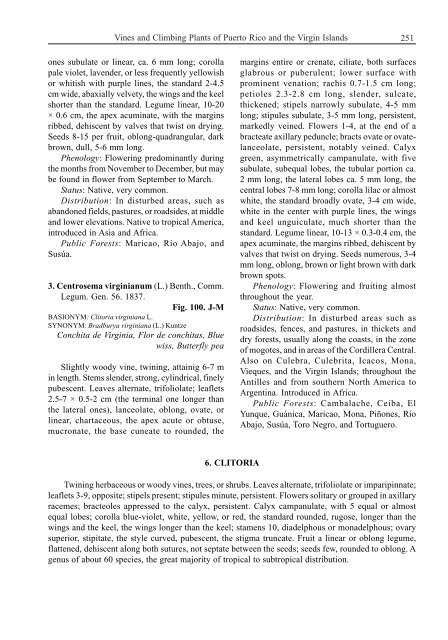Vines and Climbing Plants of Puerto Rico and the Virgin Islands
Vines and Climbing Plants of Puerto Rico and the Virgin Islands
Vines and Climbing Plants of Puerto Rico and the Virgin Islands
You also want an ePaper? Increase the reach of your titles
YUMPU automatically turns print PDFs into web optimized ePapers that Google loves.
<strong>Vines</strong> <strong>and</strong> <strong>Climbing</strong> <strong>Plants</strong> <strong>of</strong> <strong>Puerto</strong> <strong>Rico</strong> <strong>and</strong> <strong>the</strong> <strong>Virgin</strong> Isl<strong>and</strong>s 251<br />
ones subulate or linear, ca. 6 mm long; corolla<br />
pale violet, lavender, or less frequently yellowish<br />
or whitish with purple lines, <strong>the</strong> st<strong>and</strong>ard 2-4.5<br />
cm wide, abaxially velvety, <strong>the</strong> wings <strong>and</strong> <strong>the</strong> keel<br />
shorter than <strong>the</strong> st<strong>and</strong>ard. Legume linear, 10-20<br />
× 0.6 cm, <strong>the</strong> apex acuminate, with <strong>the</strong> margins<br />
ribbed, dehiscent by valves that twist on drying.<br />
Seeds 8-15 per fruit, oblong-quadrangular, dark<br />
brown, dull, 5-6 mm long.<br />
Phenology: Flowering predominantly during<br />
<strong>the</strong> months from November to December, but may<br />
be found in flower from September to March.<br />
Status: Native, very common.<br />
Distribution: In disturbed areas, such as<br />
ab<strong>and</strong>oned fields, pastures, or roadsides, at middle<br />
<strong>and</strong> lower elevations. Native to tropical America,<br />
introduced in Asia <strong>and</strong> Africa.<br />
Public Forests: Maricao, Río Abajo, <strong>and</strong><br />
Susúa.<br />
3. Centrosema virginianum (L.) Benth., Comm.<br />
Legum. Gen. 56. 1837.<br />
Fig. 100. J-M<br />
BASIONYM: Clitoria virginiana L.<br />
SYNONYM: Bradburya virginiana (L.) Kuntze<br />
Conchita de <strong>Virgin</strong>ia, Flor de conchitas, Blue<br />
wiss, Butterfly pea<br />
Slightly woody vine, twining, attainig 6-7 m<br />
in length. Stems slender, strong, cylindrical, finely<br />
pubescent. Leaves alternate, trifoliolate; leaflets<br />
2.5-7 × 0.5-2 cm (<strong>the</strong> terminal one longer than<br />
<strong>the</strong> lateral ones), lanceolate, oblong, ovate, or<br />
linear, chartaceous, <strong>the</strong> apex acute or obtuse,<br />
mucronate, <strong>the</strong> base cuneate to rounded, <strong>the</strong><br />
6. CLITORIA<br />
margins entire or crenate, ciliate, both surfaces<br />
glabrous or puberulent; lower surface with<br />
prominent venation; rachis 0.7-1.5 cm long;<br />
petioles 2.3-2.8 cm long, slender, sulcate,<br />
thickened; stipels narrowly subulate, 4-5 mm<br />
long; stipules subulate, 3-5 mm long, persistent,<br />
markedly veined. Flowers 1-4, at <strong>the</strong> end <strong>of</strong> a<br />
bracteate axillary peduncle; bracts ovate or ovatelanceolate,<br />
persistent, notably veined. Calyx<br />
green, asymmetrically campanulate, with five<br />
subulate, subequal lobes, <strong>the</strong> tubular portion ca.<br />
2 mm long, <strong>the</strong> lateral lobes ca. 5 mm long, <strong>the</strong><br />
central lobes 7-8 mm long; corolla lilac or almost<br />
white, <strong>the</strong> st<strong>and</strong>ard broadly ovate, 3-4 cm wide,<br />
white in <strong>the</strong> center with purple lines, <strong>the</strong> wings<br />
<strong>and</strong> keel unguiculate, much shorter than <strong>the</strong><br />
st<strong>and</strong>ard. Legume linear, 10-13 × 0.3-0.4 cm, <strong>the</strong><br />
apex acuminate, <strong>the</strong> margins ribbed, dehiscent by<br />
valves that twist on drying. Seeds numerous, 3-4<br />
mm long, oblong, brown or light brown with dark<br />
brown spots.<br />
Phenology: Flowering <strong>and</strong> fruiting almost<br />
throughout <strong>the</strong> year.<br />
Status: Native, very common.<br />
Distribution: In disturbed areas such as<br />
roadsides, fences, <strong>and</strong> pastures, in thickets <strong>and</strong><br />
dry forests, usually along <strong>the</strong> coasts, in <strong>the</strong> zone<br />
<strong>of</strong> mogotes, <strong>and</strong> in areas <strong>of</strong> <strong>the</strong> Cordillera Central.<br />
Also on Culebra, Culebrita, Icacos, Mona,<br />
Vieques, <strong>and</strong> <strong>the</strong> <strong>Virgin</strong> Isl<strong>and</strong>s; throughout <strong>the</strong><br />
Antilles <strong>and</strong> from sou<strong>the</strong>rn North America to<br />
Argentina. Introduced in Africa.<br />
Public Forests: Cambalache, Ceiba, El<br />
Yunque, Guánica, Maricao, Mona, Piñones, Río<br />
Abajo, Susúa, Toro Negro, <strong>and</strong> Tortuguero.<br />
Twining herbaceous or woody vines, trees, or shrubs. Leaves alternate, trifoliolate or imparipinnate;<br />
leaflets 3-9, opposite; stipels present; stipules minute, persistent. Flowers solitary or grouped in axillary<br />
racemes; bracteoles appressed to <strong>the</strong> calyx, persistent. Calyx campanulate, with 5 equal or almost<br />
equal lobes; corolla blue-violet, white, yellow, or red, <strong>the</strong> st<strong>and</strong>ard rounded, rugose, longer than <strong>the</strong><br />
wings <strong>and</strong> <strong>the</strong> keel, <strong>the</strong> wings longer than <strong>the</strong> keel; stamens 10, diadelphous or monadelphous; ovary<br />
superior, stipitate, <strong>the</strong> style curved, pubescent, <strong>the</strong> stigma truncate. Fruit a linear or oblong legume,<br />
flattened, dehiscent along both sutures, not septate between <strong>the</strong> seeds; seeds few, rounded to oblong. A<br />
genus <strong>of</strong> about 60 species, <strong>the</strong> great majority <strong>of</strong> tropical to subtropical distribution.
















